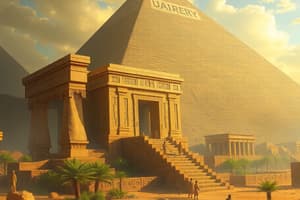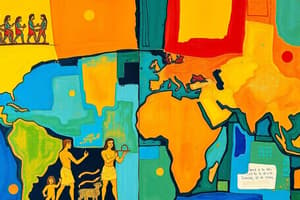Podcast
Questions and Answers
Which ancient civilization is credited with the early study of astronomy and creating the first records on clay tablets?
Which ancient civilization is credited with the early study of astronomy and creating the first records on clay tablets?
- Ancient Mesopotamia (correct)
- Ancient Rome
- Ancient Greece
- Ancient Egypt
Science in Ancient Greece was considered a separate subject from philosophy.
Science in Ancient Greece was considered a separate subject from philosophy.
False (B)
Who was the philosopher that predicted a rare solar eclipse in ancient Greece?
Who was the philosopher that predicted a rare solar eclipse in ancient Greece?
Thales of Miletus
The first seismometer was invented in __________.
The first seismometer was invented in __________.
Match the following contributions to their respective cultures:
Match the following contributions to their respective cultures:
Who proposed that the Sun is the center of the solar system?
Who proposed that the Sun is the center of the solar system?
Al-Khwarizmi is known for introducing geometry.
Al-Khwarizmi is known for introducing geometry.
What did Galileo Galilei identify using telescopes?
What did Galileo Galilei identify using telescopes?
The scientist who built the first pendulum clock in 1657 was _____ Huygens.
The scientist who built the first pendulum clock in 1657 was _____ Huygens.
Match the following scientists with their contributions:
Match the following scientists with their contributions:
Which scientist discovered the relationship between pressure and volume of gas?
Which scientist discovered the relationship between pressure and volume of gas?
Christian Huygens was an English physicist.
Christian Huygens was an English physicist.
Who is known for discovering small life forms with a microscope?
Who is known for discovering small life forms with a microscope?
Who was the first physicist to discover the electron?
Who was the first physicist to discover the electron?
Linus Pauling explained atomic bonding using classical physics.
Linus Pauling explained atomic bonding using classical physics.
What fundamental uncertainty did Werner Heisenberg illustrate?
What fundamental uncertainty did Werner Heisenberg illustrate?
Ernest Rutherford illustrated that the atom is mostly made of __________.
Ernest Rutherford illustrated that the atom is mostly made of __________.
Match the following scientists to their contributions:
Match the following scientists to their contributions:
Who is known for introducing the atomic theory into chemistry?
Who is known for introducing the atomic theory into chemistry?
Louis Pasteur is primarily known for his work on the principles of genetics.
Louis Pasteur is primarily known for his work on the principles of genetics.
What significant molecule did August Kekule discover?
What significant molecule did August Kekule discover?
Marie Curie was known for her pioneering research on ______.
Marie Curie was known for her pioneering research on ______.
Match the following scientists with their contributions:
Match the following scientists with their contributions:
Which chemist developed a full list of atomic weights?
Which chemist developed a full list of atomic weights?
Dmitri Mendeleev solved the problem of the periodic table of elements.
Dmitri Mendeleev solved the problem of the periodic table of elements.
What major concept did Alfred Russel Wallace and Charles Darwin propose?
What major concept did Alfred Russel Wallace and Charles Darwin propose?
Which scientist is known for discovering life forms with single cells?
Which scientist is known for discovering life forms with single cells?
John Ray is credited with the first systematic classification of animals.
John Ray is credited with the first systematic classification of animals.
What principle did Daniel Bernoulli formulate?
What principle did Daniel Bernoulli formulate?
_____ Cavendish illustrated that water was made of two parts of hydrogen to one part of oxygen.
_____ Cavendish illustrated that water was made of two parts of hydrogen to one part of oxygen.
Match the following scientists with their contributions:
Match the following scientists with their contributions:
Which scientist is known for developing the theory of evolution?
Which scientist is known for developing the theory of evolution?
William Herschel discovered visible light.
William Herschel discovered visible light.
Who is known for the invention of the electric battery?
Who is known for the invention of the electric battery?
Match the following discoveries with the respective scientists:
Match the following discoveries with the respective scientists:
Thomas Malthus predicted the end of the world if ____ growth was left unchecked.
Thomas Malthus predicted the end of the world if ____ growth was left unchecked.
What major work did Isaac Newton publish?
What major work did Isaac Newton publish?
Henry Cavendish conducted experiments on plant biology.
Henry Cavendish conducted experiments on plant biology.
What is one of the main contributions of George Hadley?
What is one of the main contributions of George Hadley?
Jan Ingenhousz demonstrated how green plants emitted ____ under sunlight.
Jan Ingenhousz demonstrated how green plants emitted ____ under sunlight.
Match the following scientists with their main fields:
Match the following scientists with their main fields:
Flashcards are hidden until you start studying
Study Notes
The Advent of Science (600 BC to 1400 AD)
- Early scientific studies in Mesopotamia were driven by fascination with celestial bodies.
- Sumerian high priests meticulously recorded celestial observations on clay tablets.
Science and Technology Practiced in Ancient Greece
- Thales of Miletus, a Greek philosopher, exhibited scientific thinking by predicting a solar eclipse.
- Archimedes, a Greek engineer, investigated the properties of liquids, including fluids.
- Eratosthenes calculated the Earth's circumference.
- Ctesibius designed intricate clocks.
The Onset of Science and Technology in Asia
China
- Chinese advancements included gunpowder, fireworks, rockets, weaponry, the seismometer, and the compass.
- Chinese astronomers observed supernovae.
India
- India pioneered the spinning wheel.
- Indian agricultural techniques were considered superior to those of the Chinese.
- Indian mathematicians developed the Arabic numeral system.
Ushering in the Golden Age of Islam
- The House of Wisdom library in Baghdad provided resources for astronomers and scholars.
- Arabic nomads utilized astronomy for navigation.
- Alhazen, a renowned Arab scientist, wrote a book about optics.
- Al-Razi, an Arab physician, formulated soap and distinguished between smallpox and measles.
- Al-Khwarizmi introduced algebra and algorithms.
- Al-Jazari, an engineer, implemented rod systems in mechanisms – a concept still found in cars today.
- Arab chemists made advancements in distillation and developed alkali and alcohol.
The Great Scientific Revolution of 1400 to 1700 AD
- Nicolaus Copernicus proposed a heliocentric model of the solar system.
- Johannes Kepler observed Mars' elliptical orbit.
- Galileo Galilei, using powerful telescopes, observed four of Jupiter's moons.
- Christian Huygens built the first pendulum clock.
- Francis Bacon advocated for using the scientific method.
- Robert Boyle conducted the Air Pump experiment, investigating the link between pressure and volume of gas.
- Isaac Newton proposed theories of light travel.
- Ole Rømer calculated the speed of light.
- Nicolas Steno contributed to both anatomy and geology, studying rock layers and laying the groundwork for geology.
The Age of Micro-beings
- Robert Hooke, using a microscope, observed the intricate structures of insects.
- Antonie van Leeuwenhoek, using his own microscopes, discovered microorganisms in water and single-celled organisms like bacteria.
- Jan Swammerdam studied insect development stages.
- John Ray, an English biologist, categorized plant species in an attempt to systematize the classification of organisms.
The Dawn of Mathematical Analysis
- Isaac Newton authored Philosophiæ Naturalis Principia Mathematica, which established laws of motion and gravity.
- Calculus and Newtonian physics became fundamental for future scientific investigations.
The Expansion of Scientific Horizons (1700 to 1800)
- Stephen Hales discovered root pressure and designed a gas collection trough.
- Daniel Bernoulli proposed the Bernoulli principle, which describes fluid pressure changes during movement.
- Joseph Black studied calcium carbonate decomposition and carbon dioxide extraction.
- Henry Cavendish determined the composition of water as two parts hydrogen to one part oxygen.
- Jan Ingenhousz demonstrated the role of sunlight in plant oxygen production and carbon dioxide release.
- Antoine Lavoisier explained combustion as a process of combining elements with oxygen.
- Joseph Proust established the law of definite proportions, stating that chemical elements combine in fixed ratios to form compounds.
The Field of Earth Sciences
- Benjamin Franklin studied ocean currents, particularly the Gulf Stream.
- George Hadley explained the impact of trade winds on Earth’s rotation.
- Nevil Maskelyne measured gravitational pull on a Scottish mountain to determine the Earth's density.
- James Hutton posited that the Earth was far older than previously thought.
The Basis of Life
- Georges-Louis Leclerc, a French naturalist, contributed to evolutionary theories.
- Christian Sprengel discovered that bisexual flowers could not self-fertilize due to different flowering times for male and female parts.
- Thomas Malthus explored population trends and predicted societal consequences of unchecked growth.
A Century of Development (1800-1900)
- Hans Christian Ørsted discovered a link between electricity and magnetism.
- Michael Faraday invented the first electric motor.
- James Clerk Maxwell solved the complex mathematics of electromagnetism.
Invisibility Matters
- William Herschel discovered infrared radiation, demonstrating the existence of invisible wavelengths beyond visible light.
- William Roentgen discovered x-rays during experiments in Germany.
- Thomas Young resolved the wave-particle debate about light through his studies on interference.
- Christian Doppler explained the Doppler effect, using the observation of binary stars.
- Hippolyte Fizeau and Léon Foucault measured the speed of light, discovering its faster travel through air compared to water.
Chemical Reactions
- John Dalton introduced the atomic theory to chemistry.
- Jöns Jakob Berzelius created a list of atomic weights and discovered multiple elements.
- Louis Pasteur made discoveries related to vaccination, fermentation, and pasteurization, revolutionizing disease prevention.
- August Kekule discovered the structure of the benzene molecule.
- Dmitri Mendeleev developed the periodic table of elements.
- Marie Curie conducted groundbreaking research on radioactivity and isolated polonium and radium.
Relics from the Past
- Mary Anning amassed a fossil collection of extinct animals.
- Richard Owen coined the term "dinosaurs" to describe extinct reptiles.
- Louis Agassiz proposed that significant parts of Earth were once covered in glaciers.
- Alexander von Humboldt established the study of ecology by emphasizing natural connections.
- Alfred Russel Wallace and Charles Darwin independently developed the concept of natural selection as the driving force of evolution.
- Thomas Henry Huxley theorized that birds evolved from extinct dinosaurs.
- Gregor Mendel laid the foundation for genetics.
The Dawn of a New Era (1900 to 1945)
A New-look Physics
- Max Planck discovered that electromagnetic radiation exists in discrete packets (quanta), challenging previous continuous wave models.
- Albert Einstein developed the theory of relativity, a pivotal concept in modern physics.
Wave-particle Dilemma
- Joseph John Thomson discovered electrons, identifying their negative charge and wavelike properties.
- Erwin Schrödinger formulated equations describing the probability of finding a particle in a specific location and state.
- Werner Heisenberg proposed the uncertainty principle, stating inherent limits on the accuracy of measuring position and momentum for particles.
Harnessing the Atom
- Ernest Rutherford demonstrated the atomic structure, with a small, dense nucleus surrounded by orbiting electrons.
- Linus Pauling applied quantum physics to explain atomic bonding.
- John Robert Oppenheimer led the Manhattan Project, developing the first nuclear weapons.
New Concept of the Universe
- Edwin Hubble identified nebulae as distant galaxies and observed the expansion of the universe.
Studying That Suits You
Use AI to generate personalized quizzes and flashcards to suit your learning preferences.




